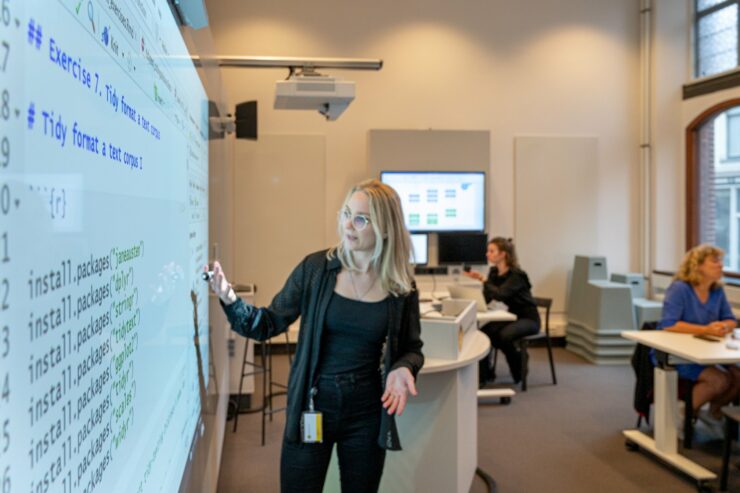One year of Living Lab Digital Humanities, how does it work in practice?
Joint programming in Python, the best place for hybrid meetings and fiddling with screens and microphones. The Living Lab Digital Humanities, a collaboration of the University Library and the Centre for Digital Humanities, was launched a year ago. Who uses this ‘workshop’ for digital research and education? What can you do there and what could be improved? The Digital Humanities support team of the University Library asked Professor Hugo Quené, Assistant Professor Pim Huijnen and scientific developers Jelte van Boheemen and Julian Gonggrijp about their experiences.

The Living Lab DH has been open for a year now, how do you like it and what do you use it for?
Hugo Quené, Professor of Quantitative Methods of Empirical Research in the Humanities, founding director of the Centre for Digital Humanities and co-founder of the Living Lab: “The LLDH offers us the opportunity to get together and work on joint projects. You can easily sit together at a large screen, consult sources, apply digital methods such as topic modeling or network analysis, and immediately discuss and adjust the results. I like it, but I think it could be used more intensively.
I myself am most often in the LLDH to give or take part in training sessions. These sessions are usually fully booked, with about sixteen people here. The set-up is ideal for a speaker to show something to a group, but also to project the work of a group or participant on the big screen and then discuss it.”
Jelte van Boheemen, scientific developer Digital Humanities: “We use the Living Lab to give internal presentations and to provide (programming) courses. Usually with one or two instructors/presenters with a small to medium group of participants of four to fifteen people.”
Julian Gonggrijp, also a scientific developer: “As far as I am concerned, it is a welcome addition to the existing facilities. For now, it is the best place in the city centre that I know of to hold hybrid presentations and meetings, where some participants are physically present and some online. All the hardware seems to work well: good image reproduction, good audio, and a fast and stable internet connection.”
Assistant Professor Pim Huijnen’s research focuses on the use of digital text analysis to investigate the history of science and ideas: “So far, I have used the lab for my educational project History in Code. In it, a small group of students (three to four) learn how to program in Python and use their skills in a collaborative research project. The great thing about the lab are the facilities, such as the possibility to connect your own laptop to external screens, both to the big screen and the smaller ones. I can share my laptop screen on the big screen, but the students in small groups can also easily share their screen. This promotes cooperation remarkably. Moreover, it makes it easy for the students and me to keep an eye on the different groups.”
The lab is set up as a meeting place, where researchers, teachers, data and software experts can meet, collaborate and exchange knowledge. It is used – by experts – almost daily. But is it commonly known at Humanities? Are your colleagues sufficiently familiar with it?
HQ: “Because of the corona era, the LLDH is not commonly known and it’s not really in the minds of everyone at the Faculty of Humanities. That could be improved. Teachers had to work very hard to teach online, and later in a hybrid form. But gradually there is more mental (and physical) space to learn new things, to start new collaborations, and to visit new places like the LLDH. I also notice this among my fellow lecturers and researchers: some have heard of the lab, but many have not. We have all worked at home for two years, and it can feel suddenly unfamiliar to work together in a different way in a new location.”
Do you have any tips? What could be improved?
HQ: “In the past, I found the technology difficult to operate, but fortunately there were always expert people around, and now there is also a manual.”
(* Support in the lab is provided by the Digital Humanities Support team of the library.)
PH: “I do have a wish list for software. If the fixed computers had Anaconda and Jupiter Notebooks for example, my students would no longer have to rely on their, sometimes, old laptops. And if you really want it to be a living lab, then put some VR glasses and a PS5 or something like that there so that
Insiders already know their way to the lab, but is there also something on the programme for DH beginners?
HQ: “Definitely! We want to start a periodic walk-in consultancy soon. Due to the corona restrictions, this has not really taken off yet. But it would be very useful to have a regular consultation hour where anyone can drop in, without an appointment, for advice and answers to short questions about data, data management, statistical analysis, Python code, R code, and so on. Hopefully that can start soon.”

- For the Living Lab Digital Humanities programme, click here.
- How to book? You can book the Living Lab via https://bookings.uu.nl/, go to ‘Meeting rooms only for UU Staff’.
This article was originally published here on uu.nl.

